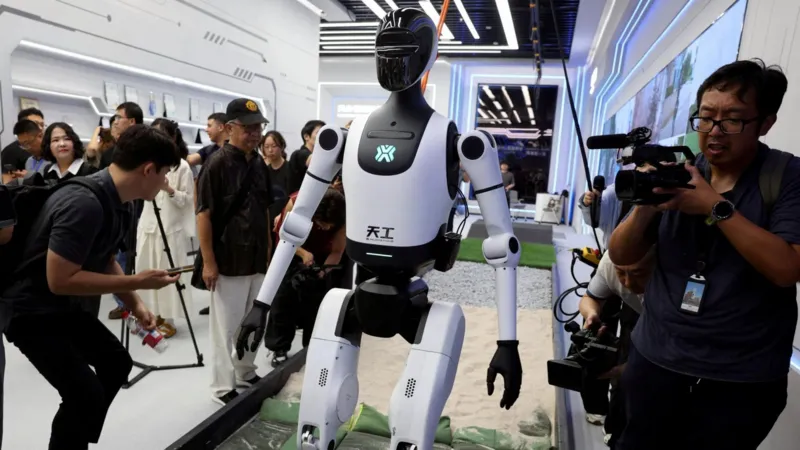How China Raced Ahead of the U.S. on Nuclear Power
Photo slide show at:
https://www.nytimes.com/interactive/202 ... e9677ea768
China is quickly becoming the global leader in nuclear power, with nearly as many reactors under construction as the rest of the world combined. While its dominance of solar panels and electric vehicles is well known, China is also building nuclear plants at an extraordinary pace. By 2030, China’s nuclear capacity is set to surpass that of the United States, the first country to split atoms to make electricity.
Many of China’s reactors are derived from American and French designs, yet China has overcome the construction delays and cost overruns that have bogged down Western efforts to expand nuclear power.
At the same time, China is pushing the envelope, making breakthroughs in next-generation nuclear technologies that have eluded the West. The country is also investing heavily in fusion, a potentially limitless source of clean power if anyone can figure out how to tame it.
Beijing’s ultimate objective is to become a supplier of nuclear power to the world, joining the rare few nations — including the United States, Russia, France and South Korea — that can design and export some of the most sophisticated machines ever invented.

A dome being placed on the Unit 1 reactor building of the Zhejiang San’ao nuclear power plant on Zhejiang Province, China, in 2022. Visual China Group, via Getty Images
“The Chinese are moving very, very fast,” said Mark Hibbs, a senior fellow at the Carnegie Endowment for Peace who has written a book on China’s nuclear program. “They are very keen to show the world that their program is unstoppable.”
As the United States and China compete for global supremacy, energy has become a geopolitical battleground. The United States, particularly under President Trump, has positioned itself as the leading supplier of fossil fuels like oil, gas and coal. China, by contrast, dominates the manufacturing of solar panels, wind turbines and batteries, seeing renewable power as the multi-trillion-dollar market of the future.
Nuclear power is enjoying a resurgence of global interest, especially as concerns about climate change mount. That’s because nuclear reactors don’t spew planet-warming emissions, unlike coal and gas plants, and can produce electricity around the clock, unlike wind and solar power.
Power ⚡︎ Moves
//
Inside China’s drive to dominate clean energy.
//There’s a Race to Power the Future. China Is Pulling Away.
https://www.nytimes.com/interactive/202 ... power.html
June 30, 2025
//Chinese Car Giants Rush Into Brazil With Dreams of Dominating a Continent
https://www.nytimes.com/2025/07/21/clim ... icles.html
July 21, 2025
//How China Went From Clean Energy Copycat to Global Innovator
https://www.nytimes.com/interactive/202 ... tents.html
Aug. 14, 2025
//Why China Built 162 Square Miles of Solar Panels on the World’s Highest Plateau
https://www.nytimes.com/2025/10/10/busi ... ateau.html
Oct. 10, 2025
//How China Powers Its Electric Cars and High-Speed Trains
https://www.nytimes.com/2025/10/11/busi ... -grid.html
Oct. 11, 2025
The Trump administration wants to quadruple U.S. nuclear power capacity by 2050, even as it ignores global warming, and it hopes to develop a new generation of reactor technology to power data centers at home and sell to energy-hungry countries overseas. Officials fear that if China dominates the nuclear export market, it could expand its global influence, since building nuclear plants abroad creates deep, decades-long relationships between countries.
Yet in the race for atomic energy, China has one clear advantage: It has figured out how to produce reactors relatively quickly and cheaply. The country now assembles reactors in just five to six years, twice as fast as Western nations.
While U.S. nuclear construction costs skyrocketed after the 1960s, they fell by half in China during the 2000s and have since stabilized, according to data published recently in Nature. (The only two U.S. reactors built this century, at the Vogtle nuclear plant in Waynesboro, Ga., took 11 years and cost $35 billion.)
Construction costs of nuclear reactors
Comanche Peak 2
Date Aug. 3, 1993
Cost/watt $8.61
Capacity 1,250 MW
Status Operating
1970
1980
1990
2000
2010
2020
$5
$10
$15 per watt
United States
China
DECREASING
INCREASING
Vogtle$15 per watt
Retired reactors
Operating reactors
Underconstruction
Hover to explore the data
Note: Reactors are placed according to the date they entered or are expected to enter commercial operation. Chart shows inflation-adjusted overnight costs, which exclude interest payments. Trend lines show linear regression slope. Source: Liu et al. 2025
“When we first got this data and saw that declining trend in China, it surprised me,” said Shangwei Liu, a research fellow at the Harvard Kennedy School of Government who led the paper.
The big questions, Mr. Liu said, are how China got so good at nuclear power — and whether the United States can catch up.
How China mastered nuclear power
A modern nuclear power plant is one of the most complex construction projects on Earth.
The reactor vessel, where atoms are split, is made of specialized steel up to 10 inches thick that must withstand bombardment by radiation for decades. That vessel, in turn, is housed in a massive containment dome, often three stories high and about as wide as the U.S. Capitol dome, made of steel-reinforced concrete to prevent dangerous leaks. Thousands of miles of piping and wiring must meet exacting safety standards.
Financing these multibillion-dollar projects is staggeringly difficult. Even minor problems, like needing regulator approval to modify a component midway through, can lead to long delays and can cause borrowing costs to skyrocket.
Over time, China has conquered this process.

Construction on a transmission tower of the Tianwan Nuclear Power Plant in Jiangsu Province in 2023. Shi Jun/Visual China Group, via Getty Images
It starts with heavy government support. Three state-owned nuclear developers receive cheap government-backed loans to build new reactors, which is valuable since financing can be one-third of costs. The Chinese government also requires electric grid operators to buy some of the power from nuclear plants at favorable rates.
Just as importantly, China’s nuclear companies build only a handful of reactor types and they do it over and over again.
That allows developers to perfect the construction process and is “essential for scaling efficiently,” said Joy Jiang, an energy innovation analyst at the Breakthrough Institute, a pro-nuclear research organization. “It means you can streamline licensing and simplify your supply chain.”
The fact that the Chinese government has a national mandate to expand nuclear power means that companies can confidently invest in domestic factories and a dedicated engineering work force. In a sprawling complex near Shanghai, giant reactor pressure vessels are being continuously forged, ready to be shipped to new projects without delay. Teams of specialized welders move seamlessly from one construction site to the next.
It’s been different in the West.
In the 1970s and 1980s, U.S. nuclear construction slowed to a trickle as interest rates rose and regulators frequently tightened safety rules, causing delays. Worries about the disposal of nuclear waste and fears after the 1979 partial meltdown of a reactor at Three Mile Island, in Pennsylvania, didn’t help. At the same time, private developers kept experimenting with new reactor designs that required different components and introduced fresh complications. U.S. nuclear power died from a lack of predictability.

Demonstrators at the Three Mile Island nuclear power plant near Harrisburg, Pa., in 1979. Bettmann, via Getty Images
The contrast became glaring in the late 2000s, when U.S. utilities tried to revive nuclear power with a new reactor model called the AP1000, with improved safety features. Developers struggled with the novel technology, leading to repeated delays and soaring costs. By the time the two reactors in Georgia were finished last year, most utilities were hesitant to try again.
As it happened, China built AP1000s at the same time. It, too, faced severe challenges, such as difficulties in obtaining coolant pumps and unpredictable cost spikes. But instead of giving up, Chinese officials studied what went wrong and concluded they needed to tweak the design and develop domestic supply chains.
“What the Chinese did was really smart,” said James Krellenstein, the chief executive of Alva Energy, a nuclear consultancy. “They said, we’re going to pause for a few years and incorporate every lesson learned.”
China is now building nine more copies of that reactor, known as the CAP1000, all on pace to be completed within five years at a drastically lower cost, an Energy Department report found.
At the Haiyang nuclear power plant, China keeps building
CHINA
Haiyang 3 and 4
Haiyang 5 and 6
Haiyang 1 and 2
Two AP1000 reactors built from
2009 to 2018
Two CAP1000 reactors, modifications
of the AP1000 design, under
construction since 2022 and 2023
Site of approved CAP1000s
200 yards
North
Satellite image from Feb. 15, 2025. Source: Airbus DS via Google
Nuclear proponents in the United States sometimes argue that overly strict safety regulations drive up costs.
China’s safety requirements are similar. But in China the approval process is more predictable, and opponents have fewer ways to challenge a project. Most reactors in China break ground weeks after receiving final approval from the safety regulator, according to research by Ms. Jiang. In the United States, by contrast, projects often need additional permits from state governments that can take months or years.
“China is practiced at building really big things, everything from dams to highways to high speed rail, and those project management skills are transferable,” said David Fishman, a power sector consultant at Lantau Group, a consulting firm.
As China, the world’s biggest emitter of greenhouse gases, seeks to curb pollution, it is counting on nuclear power to play an important role.
Solar and wind power are growing fast and account for most of China’s clean electricity, but the country also burns enormous amounts of coal to supply power when the sun isn’t shining and the wind isn’t blowing. More nuclear power could help backstop renewables and displace coal.
Electricity mix in China
0
5,000
10,000 terawatt hours
2000
2010
2020
Nuclear 4.5%
Clean 34%
Fossil fuels 62%
United States
0
5,000
10,000
2000
2010
2020
18%
24%
58%
Source: Ember Note: “Clean” includes low-carbon sources such as wind, solar, hydroelectricity and bioenergy. “Fossil fuels” includes coal, natural gas, and oil.
China’s nuclear expansion still faces hurdles. One of China’s plants suffered a smaller radioactive leak in 2021, and a bigger accident could trigger a public backlash. The country is still figuring out where to bury its nuclear waste, and some cities have seen impassioned protests over plans for waste reprocessing plants. Beijing has also blocked new reactors in much of China’s interior over concerns about their water use. If that moratorium persists, it could limit the industry’s growth.
For now, though, the country is barreling ahead, with plans to build hundreds of reactors by midcentury.
Can the U.S. catch up?
In the United States, nuclear power is one of the rare types of energy that has support from Republican and Democratic politicians alike, especially as demand for electricity rises. Even environmentalists like Al Gore who once fretted about catastrophic accidents and radioactive waste are warming to the technology.
Yet the U.S. is pursuing a starkly different path to nuclear expansion, one that leans more heavily on private innovation than government backing.
Dozens of start-ups are working on a new generation of smaller reactors meant to be cheaper than the hulking plants of old. Tech companies like Google, Amazon and OpenAI are pouring billions into nuclear start-ups like Kairos Power, X-Energy and Oklo to help power their data centers for artificial intelligence. Early projects are underway in Wyoming, Texas and Tennessee, though few, if any, new reactors are expected before the 2030s.
The Trump administration wants to accelerate this work by reducing regulations at the Nuclear Regulatory Commission, which certifies the safety of reactors before they are built. The agency’s critics say it has become too hidebound to handle advanced reactors that are less prone to meltdowns.

Energy Secretary Chris Wright speaking during the 69th annual International Atomic Energy Agency meeting in Vienna last month. Thomas Kronsteiner/Getty Images
Energy Secretary Chris Wright said that the administration is betting that the private capital flowing into nuclear projects will spark American ingenuity and catapult the U.S. ahead of China. “Entrepreneurial capitalist competition is where the U.S. thrives, and I think it’s an advantage over China,” he said in an interview.
Yet some worry that the United States is betting too heavily on technological breakthroughs instead of focusing on the financing, skills and infrastructure needed to build plants, as China has. The U.S., for instance, has lost almost all of its heavy forging capacity to make large reactor components. A new generation of advanced reactors could also take years to perfect, leaving America behind.
“You look at the number of designs, particularly in the U.S., you think, Oh, God, help us,” said Philip Andrews-Speed, a senior research fellow at the Oxford Institute for Energy Studies. “I would think narrowing down is the sensible thing to do.”
While the Trump administration has moved to speed up nuclear permitting and increase domestic supplies of nuclear fuel, some important government tools for advancing new reactors, such as the Energy Department’s loan office, have been hampered by staffing cuts. Efforts to slash safety regulations could be contentious. There is also a risk that interest by tech giants could fizzle if the A.I. boom slows.
“There’s no reason the United States couldn’t expand nuclear power,” said Stephen Ezell, vice president for global innovation policy at the Information Technology and Innovation Foundation. “But are we just going to see a few small reactors power a few data centers, or are we going to see a serious whole government approach to bring back nuclear power as an essential source of electricity?”
A race to power the world

A core module of a ACP100 multi-purpose, small modular pressurized water reactor — also called the Linglong One — a new nuclear power prototype rolling out facility in Liaoning Province in 2023. Liu Xuan/Visual China Group, via Getty Images
China’s fast-paced nuclear program is a prelude to a larger goal: dominating the global market. Chinese companies have already built six reactors in Pakistan and plan to export many more.
At the same time, China is working to surpass the United States in technological innovation. China has built what it calls the world’s first “fourth generation” reactor, a gas-cooled model that can provide heat and steam for heavy industry in addition to electricity. The Chinese are also pursuing technologies that use less uranium, such as thorium reactors, or recycle spent nuclear fuel. It’s a recognition that China doesn’t have enough domestic uranium for a massive build-out of traditional reactors.
Even if U.S. companies and labs remain at the forefront of innovation, one recent report warned that China was 10 to 15 years ahead of the United States in its ability to deploy next-generation reactors widely.
It’s a familiar story: The United States invented solar panels and batteries, only to watch as China scaled those technologies and now controls global markets.
“Maybe we can convince some of our allies not to buy Chinese reactors, but there are going to be plenty of other countries out there with growing energy demands,” said Paul Saunders, president of the Center for National Interest, a conservative-leaning think tank. “And if America isn’t ready, we won’t be able to compete.”
https://www.nytimes.com/interactive/202 ... e9677ea768











